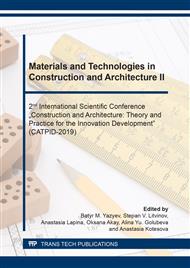p.83
p.90
p.96
p.101
p.107
p.113
p.119
p.125
p.131
Theoretical Concepts of the Modification Effect on the Interparticle Energy of the Polymer-Mineral Dispersions for 3D Printing
Abstract:
The molecular gravity and electrostatic repulsion energies were calculated taking into account the structural forces between the modified particles of the polymer-chalk dispersion, which was chosen as a model polymer-chalk system when studying systems for the innovative construction industry using additive technologies (3D printing). In the above calculations, differences for the studied systems are taken into account in such quantities as the complex Hamaker constant, the ionic strength of the solution, and the diffuse layer potential. The calculation of the total potential curves of modified and unmodified polymer-chalk dispersions and the contribution of various factors of aggregative stability analysis showed that as a result of the adsorption of modifier molecules on the particles surface, the action of molecular attraction forces is overcome by the combined action of electrostatic and adsorption-solvate factors of aggregative stability.
Info:
Periodical:
Pages:
107-112
Citation:
Online since:
December 2019
Authors:
Price:
Сopyright:
© 2020 Trans Tech Publications Ltd. All Rights Reserved
Share:
Citation:


